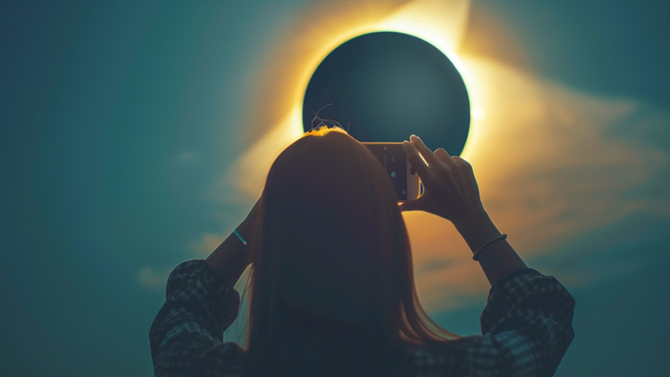On April 8, 2024, a spectacular celestial event will grace the skies of the United States. A total solar eclipse, a phenomenon visible in the U.S. only 10 times this century, will traverse a 115-mile-wide path, starting in Texas and passing through major cities including Austin, Dallas, Little Rock, Carbondale, Indianapolis, Dayton, Cleveland, Buffalo, and Burlington. If you’re fortunate enough to be in this path of totality, you will witness a breathtaking few minutes when the moon completely blocks out the sun, turning day into night.

If you're planning to photograph this rare event with your smartphone, you're in luck. With the right preparation and techniques, you can capture stunning images of the eclipse. However, it's critical to prioritize eye safety and use proper solar filters to protect both your eyes and your smartphone's camera.
From using solar filters to adjusting camera settings and composing your shots, there’s a lot you can do to get the perfect shots. The key to success is preparation. Here’s what you need to do before the eclipse occurs.
Use a solar filter
First and foremost, safety should be your top priority when photographing the solar eclipse. Never look directly at the sun without proper eye protection, even during the eclipse. The same rule applies to your smartphone's camera. Exposing your phone's camera to direct sunlight can cause irreversible damage to the sensor.
To prevent this damage, you must cover the lens with a solar filter designed specifically for photography. These filters are made with materials that block out most of the sun's light, allowing only a small fraction to pass through. This not only protects your camera but also ensures that you capture the eclipse's details without overexposure.
We recommend using the VisiSolar Smartphone Photo Filter, available on Amazon for $8.99. This filter is specifically designed for smartphones and easily attaches to your device's lens. However, it's important to note that this filter is only meant for your phone's camera and should not be used to look at the sun directly. Always use certified eclipse glasses to view the eclipse with your own eyes.
Read more: What's Draining Your Android Battery?
Stabilize your phone
When it comes to photographing the solar eclipse, a steady hand is crucial for capturing sharp, clear images. Even the slightest movement can cause blurriness and ruin your shot. To minimize camera shake, it's essential to stabilize your smartphone.
One of the best ways to achieve stability is by using a tripod. Smartphone tripods are compact, lightweight, and easy to set up, making them perfect for on-the-go photography. Look for a tripod with a smartphone adapter or clamp that securely holds your device in place. By mounting your phone on a tripod, you'll ensure that it remains still throughout the entire eclipse.
If you don't have a tripod, don't worry. You can still stabilize your phone by leaning it against a stable object, such as a wall, a tree, or a rock. Just make sure that the surface is sturdy and won't move or vibrate during the eclipse.
Another helpful tip is to use your body to create additional stability. Tuck your elbows in close to your body and hold your breath while taking the shot. This will help minimize any hand tremors that could blur your image.
By stabilizing your smartphone, you'll be able to capture crisp, detailed images of the solar eclipse that you'll be proud to share with friends and family.
Read more: How to Use Your Phone as a Webcam
Optimize your camera settings
To capture stunning images of the solar eclipse with your smartphone, it's essential to adjust your camera settings for optimal results. While most smartphones have capable automatic modes, taking control of your camera's manual settings will give you more flexibility and help you achieve the desired effect.
First, if your smartphone has a manual mode, switch to it. This will allow you to adjust settings like ISO, shutter speed, and focus. If your phone doesn't have a manual mode, look for an app that provides manual control, such as Hallide Mark II Pro Camera (for iOS, $0.99 per month or $59.99 one-time fee) or Adobe Lightroom (for Android, free for the camera features. Go into the Edits tab to find the camera).
Next, set your camera's ISO to the lowest available setting, typically 100 or 50. A low ISO will help minimize noise and grain in your images, resulting in cleaner, crisper shots.
Shutter speed is another crucial setting to consider. To capture the eclipse's details without overexposure, use a fast shutter speed between 1/1000 and 1/4000 of a second. This will help freeze the motion of the eclipse and ensure sharp images.
Finally, adjust your camera's focus to infinity. This setting will ensure that the eclipse and any distant foreground elements, such as landscapes, remain in focus. If your smartphone doesn't have an infinity focus option, you can manually focus on a distant object before the eclipse begins.
Read more: Artificial Intelligence Can't Replace Headshot Photographers Yet
Use time-delay to reduce camera shake
When photographing the solar eclipse, even the slightest movement can cause camera shake and blur your images. Pressing the shutter button on your smartphone can be enough to introduce unwanted vibrations, especially if you're using a tripod or leaning your phone against a stable object.
To avoid this, consider using your smartphone's built-in timer. Most smartphones have a timer function that allows you to set a delay of 3 or 10 seconds before the camera takes the picture. This gives you enough time to press the shutter button and then let go, allowing the phone to stabilize before capturing the image.
Compose your shots
While the solar eclipse itself is undoubtedly the star of the show, don't forget to consider the overall composition of your image. A well-composed shot can take your eclipse photography from good to great, adding visual interest and context to the celestial event.
One way to elevate your composition is by including an interesting foreground element or landscape. This could be a silhouette of a tree, a cityscape, or a natural feature like a mountain or a lake. By incorporating these elements into your shot, you'll create a sense of scale and give viewers a point of reference for the eclipse.
When composing your shot, also consider the rule of thirds. Imagine your frame divided into a 3x3 grid, and place the eclipse along one of the grid lines or at one of the intersections. This will create a more balanced and visually appealing image than simply centering the eclipse in the frame.
Another tip is to experiment with different perspectives. Instead of shooting the eclipse straight-on, try tilting your camera up to capture a more expansive view of the sky. Or, get low to the ground and shoot the eclipse as it appears over a landscape or cityscape.
Remember, the solar eclipse will be in motion, so take some time to plan your composition ahead of the event. Scout your location, consider the eclipse's path across the sky, and think about how you can use the environment to create a unique and compelling image.
Read more: 14 Reasons Why Your Computer is Slow
Final thoughts
Photographing the 2024 solar eclipse with your smartphone is an exciting opportunity to capture a rare celestial event – the next to cross the United States will be in 2044. By following these tips and techniques, you'll be well-prepared to create stunning images safely.
[Image credit: Person taking a picture of a solar eclipse generated by Midjourney]
For the past 20+ years, Techlicious founder Suzanne Kantra has been exploring and writing about the world’s most exciting and important science and technology issues. Prior to Techlicious, Suzanne was the Technology Editor for Martha Stewart Living Omnimedia and the Senior Technology Editor for Popular Science. Suzanne has been featured on CNN, CBS, and NBC.














